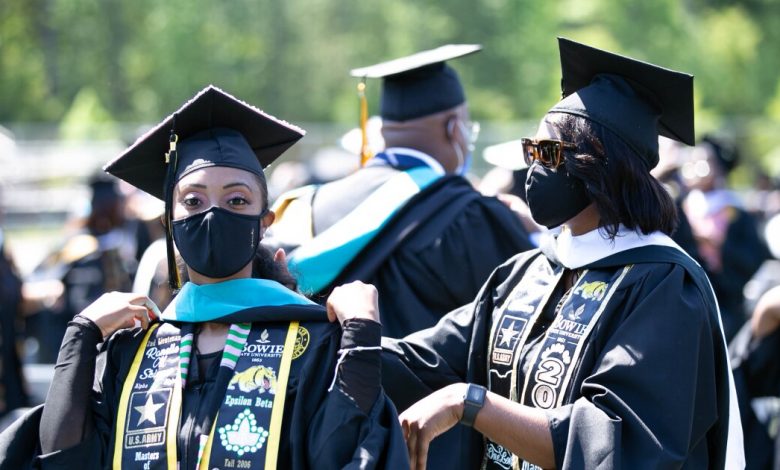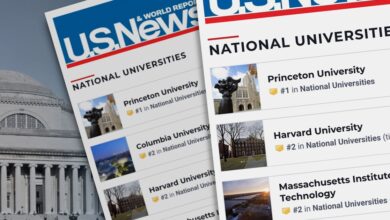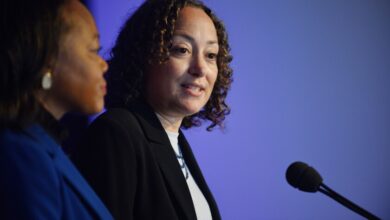What MacKenzie Scott’s Millions Have Meant to HBCUs

[ad_1]
In October, Madison Byrdie checked her financial-aid statement and noticed something had changed. A $1,500 credit had been applied to her tuition bill overnight.
Just the week before, the sophomore at Xavier University of Louisiana had talked to her mother about getting another job — she already worked as a resident assistant — to help cover some of her school bills. It had been a stressful semester, what with hunting for scholarships, applying for paid internships, and organizing campus events, all while maintaining a 3.75 GPA.
Looking ahead, she knew she didn’t have enough money to pay for two more years of college.
But then came the good news. In the fall, Xavier gave 60 students $3,000 need-based scholarships, to be distributed over the course of the academic year. The funds came thanks to a historic windfall: the philanthropist MacKenzie Scott’s $20-million donation to the university.
It’s been a little over a year since Scott announced that she had added nearly three dozen colleges — many of them historically Black — to the previously short list of institutions upon which she planned to bestow billions from her fortune. In that time, most of them have begun putting the money to work. They’re using it in a myriad of ways: need-based scholarships for students, improving the working conditions for faculty and staff, and adding programming in STEM fields and the arts.
How these colleges have used the money reveals what happens when chronically underfunded institutions get access to large unrestricted gifts. This transformation has come at institutions that are typically overlooked, places like Bowie State University, in Maryland, and Voorhees College, in South Carolina. “I don’t think we’ve ever seen that amount across several institutions,” said Steve D. Mobley Jr., an assistant professor of higher education and administration at the University of Alabama. “There are some HBCUs that are often cherry-picked to get a lot of money.”
One year later, the money has already improved the everyday lives of some people who live and work on these campuses. Students with lighter tuition bills. Employees with better health care and pay. High-school students with access to visionary artists. “People don’t realize how little things like this impact people and allow them to continue their passion or give back to the world or just do the things that they want without the pressure of money,” Byrdie said.
Money for Students
Last year, almost every HBCU that received a donation from Scott pledged to put a portion of the funding toward need-based scholarships for students. Xavier, which was among Scott’s first slate of beneficiaries, expanded its need-based scholarship fund by $15 million, according to a report detailing how administrators have used the money.
Prairie View A&M University, which received $50 million from Scott, allocated $10 million to its Panther Success Grant program, which helps juniors and seniors move closer to graduation. More than 4,000 students received grants and 431 of them graduated by the summer of 2021. In an email to The Chronicle, James M. Palmer, the provost, said the funds were the “critical difference” that kept students enrolled during the pandemic, which limited work opportunities.
We’re going to try to go after valedictorians with full scholarships.
Prairie View also put $10 million into a scholarship endowment aimed at recruiting high-achieving students from high schools nearby and nationwide. “We’re going to try to go after valedictorians with full scholarships,” Palmer said.
North Carolina A&T State University, which received $45 million, created the February One Scholars Program in honor of the day four students staged a sit-in at a segregated lunch counter in 1960. The scholarship will give 15 freshmen full-ride scholarships. The institution will also pool some of the money from Scott with federal Higher Education Emergency Relief Funds to help students cover technology, textbooks, and living expenses through the pandemic.
A focus on tuition relief could make sense, given the colleges that Scott targeted. A study led by a scholar from Rutgers University identified commonalities among the institutions that were chosen. The HBCUs that received donations enrolled more first-time college students than non-recipients, and typically had higher tuition and fees, among other things.
The ‘Basic Things’
Voorhees College, which received $4 million, used a portion of the gift to reinstate health-care benefits for employees. Because of high claims costs, Voorhees had stopped providing a group medical plan for its employees in 2015. Paying the Affordable Care Act penalty was cheaper for the college than providing coverage, said Constance Colter-Brabham, the director of human resources, in an email.
The college will now contribute 75 percent toward employees’ coverage as part of the reinstated plan, which took effect in January.
Similarly, North Carolina A&T provided raises for its employees for the first time in four years with the recently approved biennial state budget. With the Scott money, the university has funded new staff-recognition initiatives, which “will aid A&T’s retention of strong employees, as well as morale and workplace satisfaction,” according to a report obtained by The Chronicle that breaks down how the university has appropriated the donation in the past year.
The donations lessen some of the stress put on HBCUs to “do so much with so little,” said Mobley, of Alabama. “When you have smaller, private HBCUs that are able to get this amount of money, it allows them to do basic things so they can move on to bigger things.”
“If you’re worrying about faculty health benefits, you literally, perhaps, do not have the time to write a grant or compete for other funding because you’re trying to meet the basic needs of your students, faculty, and administrators.”
Other institutions are using Scott’s money to create new positions. Morgan State, which received $40 million, used $3 million — which the State of Maryland matched — to endow three new professorships: a chair in brain science, one in psychometrics and predictive analytics, and one in cybersecurity engineering.
The wide variety of initiatives — from basic staff support to the funding of new positions in cutting-edge fields — would not be possible if not for the unrestricted nature of the donations.
The utility of unrestricted funds cannot be overstressed.
“The utility of unrestricted funds cannot be overstressed,” said Kayla Elliott, director of higher-education policy at the Education Trust. She added that putting some of the funding towards supporting faculty indirectly supports students. “Oftentimes institutions have to make investments into faculty, investments into infrastructure, investments into indirect costs that don’t go directly to students in order to support students,” she said.
Prairie View is seeking to fill 23 new tenure-track faculty positions with the additional funding, with $10 million going toward faculty start-up packages. “We’re actually attracting individuals who were already tenured at other institutions,” Palmer said.
While Palmer looked to faculty recruitment, he wanted to make sure that they were improving conditions for existing faculty as well. So Prairie View also put $5 million toward a faculty-development endowment intended to support faculty research and other activities.
North Carolina A&T established a faculty sabbatical program where two tenured faculty members per year can take paid time off to focus on projects that advance teaching, research, and service. Before the donation, the university had never had the resources to support such a program.
Pipeline Programming
Some colleges are also using the money to help middle- and high-school students in underserved communities. In some cases, they’re using the funds to bolster existing college-prep resources and in other cases, they’ve created new ones.
Xavier put $1 million into its existing Pipeline Endowment Fund, which supports pre-collegiate summer programs for middle- and high-school students. Part of the money also went to two programs for middle- and high-school students interested in STEM fields.
Prairie View A&M is using some of its Scott money for a similar focus on pre-college students. The university’s Toni Morrison Writing Program will partner with local high-school English departments, sponsor an annual writing contest in local schools, and offer elementary-school readings accompanied by informal book discussions with Nikki Giovanni, the poet and activist hired as the university’s inaugural writer in residence — all made possible by Scott’s gift.
“These programs don’t get the high dollars,” said Emma Joahanne Thomas-Smith, director of the writing program. “They’re just as important as STEM.” Morgan State and North Carolina A&T are using the money to start similar initiatives.
The wide variety of uses for the $560 million Scott has pledged to HBCUs makes sense, given their roles in the communities they serve, said Felecia Commodore, an assistant professor of higher education at Old Dominion University. HBCUs are “an important access point for students who are often marginalized,” Commodore said. She added that the colleges often serve as engines of social mobility for students and their families but that their needs may vary.
“For some institutions, that means helping these students who need the resources to graduate,” she said. “For other institutions, it may mean updating our labs because we’re trying to strengthen our engineering program or STEM programs and we’re the main access point for Black students to access STEM degrees.”
[ad_2]
Source link






